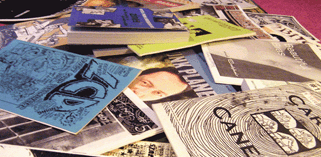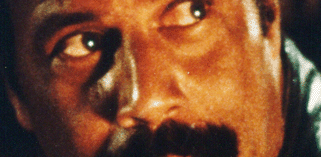Editor’s Note: I originally wrote this for issue #46 of the Philadelphia music magazine WonkaVision. Unfortunately, the magazine ceased publication, and issue 46 was never released. I was a huge collector and fan of printed zines back in the 80’s and 90’s, and reached out to some of the creators whose work I loved to talk about the lost art of the zine.
“I know a place…where people discuss the merits of Japanese monster movies….one where men grapple with feminism and what it means to their lives – and where women can be alone for a moment without the presence of men… one where workers, from old-line unionists to new burger-flippers, talk about work in their own words…one where millions of facts, near-facts, rumors, suspicions and downright lies are available to anyone who cares to look for them.” – Mike Gunderloy, founding editor, Factsheet 5, in a column published in Whole Earth Review in 1990.
Before the web and social networking sites like Facebook and even MySpace existed, many people expressed their individualism, opinions, artistic expressions and niche expertise through the independent production of little photocopied paper booklets called zines. It was a scene ruled largely by teens and young adults, fueled by a punk rock sense of independence and disenfranchisement. During the 1980’s and 1990’s, there was an explosion in the number of zines produced annually, but the numbers have been in decline since social networks became popular. I used Facebook to track down a few zine creators from that era to see how their zine experiences shaped who they are now, and whether social networks have replaced zines for them.
IF YOU DON’T PLAY, YOU STILL HAVE TO COMMUNICATE
It is no coincidence that zines and punk rock rose in popularity together. At its core, punk rock embraces a “do-it-yourself” mentality. Those who could play an instrument, even if they couldn’t play well at the beginning, created bands in their garages and played to their friends in tiny rooms. Others created zines and passed them out to their friends in those same rooms. With either a band or a zine, you could participate in your town’s punk rock community.
Allison Burger is a wife and mother who also works as an Evaluation Specialist for a non-profit organization addressing maternal and child health. She periodically writes articles for magazines, but more often expresses herself through her interactions with children and her community. A typical routine for a typical mom, except Burger is the mom who stresses do-it-yourself ideals and can’t always keep her punk-rock sensibilities under wraps.
In the mid-90’s, Allison was a teenage girl living in Philadelphia’s suburbs. Between ages 15 and 22, she created several different zines, including Demigod, Ascension and Girl Face Girl, and distributed them in and around Philadelphia on her own. “I was captivated by the free exchange of ideas, as well as the accessibility of writing a zine,” she recalls. “Nearly anyone could do it, given a source of affordable copying and networks of distribution. I have always been a do-it-yourselfer.”
The subject material for Burger’s zines was dictated by her own explorations, both creatively and philosophically. “For better or for worse,” she says, “I wanted to share all of the punk and feminist ideas incubating in my head, as well as some of the fiction and poetry I wrote…and some of it was just plain fun, like interviewing friends’ bands or reviewing shows I went to or being a smart ass or whatever. I also did some ranting.”
It’s difficult now for her to remember how much time she spent making zines. Zine production was her art for a while, and it was integrated into her life. Now, as a busy parent, her children have become her primary creative outlet. Although she maintains a Facebook page and enjoys blogging occasionally, Allison doesn’t feel the web can replace zines.
“I think social networking sites can never replace the personal connections people who made zines often formed with each other, and those who read their zines, through handwritten letters and mixtapes,” Burger says. “I often think social networking sites offer quantity, as in reaching many people very quickly, versus quality, as in meeting the person whose zine you are reading.”
DIGGING INTO THE MINUTIAE OF EVERYDAY LIFE
About 10 years ago on the opposite coast, Californians Julie Fredericksen and Tommy Kovac created the zine Library Bonnet while working together in a school library. Both “were always amused by the catalogs, memos, and other fussy missives that go with library work,” according to Fredericksen. “We had seen a few other zines and wanted to make our own, focusing on library topics and other silly things that struck our fancy.” Library Bonnet came about “in a gush of amniotic fluid and piercing screams,” Kovac adds.
Fredericksen, now married, still lives in California and still works in a public library, but as the director. Looking back on the zine explosion, she says, “They represent a crucial sea-change, where free thought and spilling out one’s interests and silly/serious thoughts to others was allowed to blossom. It was also a way to publish without relying on the nearly impenetrable publishing world.”
The way Fredericksen sees it, zines were a definite precursor to blogs, Youtube videos, all the self-expression that we see now on the web. Still, she laments the lack of public embrace of zines. “I find that most adults just don’t have time for much silliness or flights of fancy. It’s a shame.”
Fredericksen views the web as lacking the sense of absolute individuality that is a base quality of zines. “Blogs and websites are plagued with clutter and things to click on and link to and add to that overall cacophony that computers add to our lives,” she says. “A zine stands alone. The handmade quality can’t be replicated.”
When she’s feeling especially corporate or boring, Fredericksen likes knowing that she has some very creative and off-putting zines tucked away that a lot of people liked. “It also makes me more appreciative of small press endeavors that I occasionally see in small, independent stores,” she says. “They all share my fascination with minutiae and random topics.”
Fredericksen’s creative partner, Tommy Kovac, is a writer and illustrator who went on to work in comics. He wrote the graphic novel Wonderland for Disney Press, and wrote and illustrated Stitch, Skelebunnies and Autumn for Slave Labor Graphics Publishing. He is currently writing a new comic book series, The Royal Historian of Oz.
Kovac enjoys bouncing between corporate and DIY art, and feels it contributes a sense of balance to his life. “If I’ve spent hours working on painstaking fine detail, or stressing over the final edit of one of my scripts, feeling like it all has to be as perfect as I can make it for professional publication, it’s nice when I’m done to be able to kick back on the floor and tape together something for the zine using clip art and something I wrote in 5 minutes,” he says. “With zines I don’t worry about marketability or reviews. I just experiment, and communicate thoughts and ideas.”
Creating zines has had a lasting impact on Tommy Kovac. “Having done that, I feel there’s almost no limit to the things I can do on my own,” he explains. “I think it empowered me, especially getting positive responses from people all over the world. And being able to call myself a zinester adds something to my general self-perception, something kind of punk-ass and cool. It’s nice to think about when I’m having a really dumb, mundane kind of day at work.” Keeping up with the demands of family life and two careers hasn’t left him much time to explore the zine world. “I’m definitely not creating as much zine material as I used to, but I still enjoy DIY stuff,” says Kovac. Still, his artistic expressions remain strong. “Lately I’ve been drawing on library supplies (like checkout cards) and turning them into bookmarks. I learned to make real tassels for them using embroidery thread and a sewing needle. I’m lucky to also have the creative outlet of getting my comics published by SLG Publishing and Disney Press.”
Kovac also thinks the web can’t replace the zine experience. “You can’t put web pages on a shelf and gaze at them fondly,” he says. “You can’t loan a web page to a friend, or mail one to a fellow creator you admire. The most recent zine I did had a separate tiny little book in the center of it, held in place by a strip of patterned origami paper. Can’t do that on the web.” Kovac challenges his zine readers to decide which is better: a web-page with an interactive unicorn, or a real unicorn. He also compares the web to the idea of reading only material on the bestseller lists. “You’ll miss out on some of the most entertaining, human, and thought-provoking stuff out there,” he says. “It’s totally worth it to do a little digging, or to drive a little out of your way to a place that supports independent writing and art.”
THE DIY SPIRIT IS ALIVE AND WELL
Are any of them planning to return to the world of creating zines?
Allison Burger thinks about it from time to time. “My sister was encouraging me to write another zine just last night,” she says. “I think participating in a community of zine-making, and punk rock/hardcore music in general, caused me to value community in its various forms.” She continues to maintain her punk and DIY roots, but has adapted them to new roles. “A friend and I have started a Green Arts program that we do for our town’s summer camp program and at the local PTA’s Spring Fling,” says Burger. She is also actively involved with a local DIY group that organizes artistic experiences for children.
“I definitely feel this void,” explains Fredericksen. “But Tommy and I plan to produce Library Bonnet issue 9! A hard rain is a-gonna fall.” Kovac also confirmed plans for a new issue of Library Bonnet. “We’re getting ready to start that up again, so look out, world!” he says. “Bitches better get ready.”




